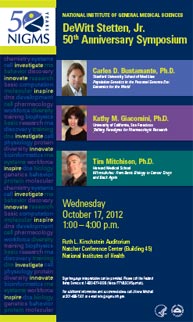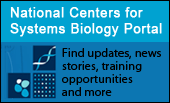 For 10 years, our National Centers for Systems Biology (NCSB) program has enabled pioneering research, research training, education and outreach programs focused on systems-level inquiries of biomedical phenomena within the NIGMS mission.
For 10 years, our National Centers for Systems Biology (NCSB) program has enabled pioneering research, research training, education and outreach programs focused on systems-level inquiries of biomedical phenomena within the NIGMS mission.
Currently, the program funds 15 centers that are focused on molecular and cellular biology, genetics, pharmacology and physiology. The centers have advanced research in these scientific areas and have significantly contributed to the development of systems biology courses, graduate programs and departments at institutions across the nation, supporting and further building research teams that integrate expertise across traditional disciplinary boundaries.
To mark the program’s anniversary, we are hosting a special annual centers meeting to inform the broader scientific community about the status and achievements of the program. In addition to presentations highlighting each center’s activities, the agenda includes a plenary talk by Arthur Lander of the University of California, Irvine, titled “Lighting the Way: Ten Years of National Centers for Systems Biology,” and presentations by young scientists whose careers have been impacted by the program.
The meeting will be held on July 11-12 in the Natcher Conference Center on the NIH campus. You can now register to attend and see who is participating (no longer available).
Here are a few examples of how the research being conducted by the NIGMS-funded systems biology centers is advancing our knowledge in a broad range of scientific areas:
- The Virtual Physiological Rat Project
 at the Medical College of Wisconsin used data analysis and computational modeling to show that arterial stiffening alone best explains the development of hypertension in aging individuals; the methodology can serve as a model for studying the basis of other diseases.
at the Medical College of Wisconsin used data analysis and computational modeling to show that arterial stiffening alone best explains the development of hypertension in aging individuals; the methodology can serve as a model for studying the basis of other diseases.
- The Center for Systems and Synthetic Biology at the University of California, San Francisco, has created minimal circuits that can reprogram the self-organization of structures within the cell, offering a potential method for engineering cells to carry out specific therapeutic functions.
- Using dynamical modeling, the San Diego Center for Systems Biology at the University of California, San Diego, has helped explain how quantitative differences in epigenetic steady states may result in qualitatively different cell-type-specific control of signaling.
- The Center for Complex Biological Systems at the University of California, Irvine, has provided novel insights into the strategies underlying robust pattern formation in biological systems.
- The Center for Modular Biology at Harvard University has explored whether networks of interacting components, or modules, are pervasive building blocks in biological systems, and how the existence of these building blocks restrains or enhances the generation of diversity.
- The Center for Systems Biology
 at the Institute for Systems Biology is seeking out how dynamic molecular networks of cells process inputs from their environment to mount appropriate responses, such as metabolic, morphological and phenotypic changes.
at the Institute for Systems Biology is seeking out how dynamic molecular networks of cells process inputs from their environment to mount appropriate responses, such as metabolic, morphological and phenotypic changes.
- The Center for Genome Dynamics
 at the Jackson Laboratory has developed and commercialized two highly sought-after genotyping platforms that are useful in mouse research.
at the Jackson Laboratory has developed and commercialized two highly sought-after genotyping platforms that are useful in mouse research.
For more highlights, including a recent award from Science magazine for an online computational biology course from the Center for Genome Dynamics, see the NCSB news page. An array of databases, software and other resources, including training materials, developed by the centers are available for use through the NCSB portal (no longer available).


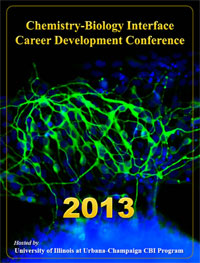 An action recommended in our strategic plan for biomedical and behavioral research training and by a working group of the Advisory Committee to the Director, NIH, is providing graduate students with a greater awareness of their career options. An inaugural career development conference that we co-sponsored and that was recently highlighted in a
An action recommended in our strategic plan for biomedical and behavioral research training and by a working group of the Advisory Committee to the Director, NIH, is providing graduate students with a greater awareness of their career options. An inaugural career development conference that we co-sponsored and that was recently highlighted in a  For 10 years, our
For 10 years, our 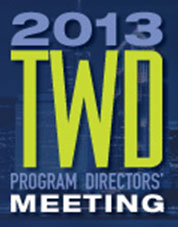 A goal of our
A goal of our 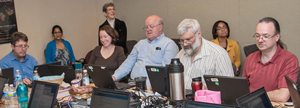 Last Friday, we hosted Cell Day–an extremely exciting online interactive chat about the cell. During the event, many members of our scientific staff, including our Acting Director, Judith Greenberg, fielded more than 140 questions from mostly 5th through 12th grade students and teachers across the country.
Last Friday, we hosted Cell Day–an extremely exciting online interactive chat about the cell. During the event, many members of our scientific staff, including our Acting Director, Judith Greenberg, fielded more than 140 questions from mostly 5th through 12th grade students and teachers across the country.